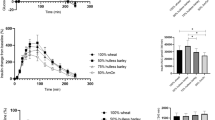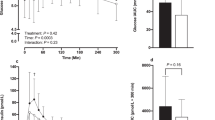Abstract
Objective:
To examine the effect of barley flour (barley cultivar, Hordeum Vulgare var Himalaya 292) incorporated into breakfast and lunch compared with otherwise identical meals containing white wheat flour on the thermic effect of food (TEF), subsequent food intake and metabolic parameters.
Design:
Randomized single blinded crossover study.
Setting:
Outpatient setting.
Subjects and methods:
Fourteen healthy women consumed a test breakfast at 0700 h. Energy expenditure, respiratory quotient (RQ), appetite ratings using a visual analogue scale (VAS), insulin and glucose levels were measured before and after a test lunch at 1330 h. Food intake was recorded for the remainder of the day.
Results:
The TEF was 5% for both test lunches and meal type did not affect any variable measured by the VAS. There was an increase in post-prandial RQ above baseline (0.80) independent of treatment (0.88 and 0.90 for barley and wheat-containg meals, respectively, P<0.001). Mean area under the glycaemic response curve (AUC) for wheat-containing meals was 4.68±1.67 mmol/l/h, 22% higher than for the barley-containing meals (3.67±1.91 mmol/l/h), P=0.05. AUC of insulin in response to wheat-containing meals (78.1±35.3 mIU/l/h) was 32% greater than barley-containing meals (52.8±24.7 mU/l/h), P<0.02. Ad libitum food intake over the next 10 h was reduced by 23% (9.6 vs 11.0 MJ, P<0.05) after the wheat-containing meals compared to the barley-containing glycaemic index meals.
Conclusion:
Inclusion of an ingredient containing increased soluble fibre and amylose did not reduce spontaneous food intake but rather was associated with higher subsequent energy intakes despite its reduced glycaemic and insulinemic effects.
Sponsorship:
CSIRO, Human Nutrition, Adelaide, Australia.
This is a preview of subscription content, access via your institution
Access options
Subscribe to this journal
Receive 12 print issues and online access
$259.00 per year
only $21.58 per issue
Buy this article
- Purchase on Springer Link
- Instant access to full article PDF
Prices may be subject to local taxes which are calculated during checkout



Similar content being viewed by others

References
Anderson GH, Catherine NLA, Woodend DM, Wolever TMS (2002). Inverse association between the effect of carbohydrates on blood glucose and subsequent short-term food intake in young men. Am J Clin Nutr 76, 1023–1030.
Anderson GH, Woodend D (2003). Effect of glycemic carbohydrates on short-term satiety and food intake. Nutr Rev 61, S17–S26.
Ball SD, Keller KR, Moyer-Mileur LJ, Ding YW, Donaldson D, Jackson WD (2003). Prolongation of satiety after low versus moderately high glycemic index meals in obese adolescents. Pediatrics 111, 488–494.
Biorklund M, van Rees A, Mensink RP, Onning G (2005). Changes in serum lipids and postprandial glucose and insulin concentrations after consumption of beverages with beta-glucans from oats or barley: a randomised dose-controlled trial. Eur J Clin Nutr 59, 1272–1281.
Bird AR, Flory C, Davies DA, Usher S, Topping DL (2004). A novel barley cultivar (Himalaya 292) with a specific gene mutation in starch synthase IIa raises large bowel starch and short-chain fatty acids in rats. J Nutr 134, 831–835.
Brand-Miller JC, Holt SH, Pawlak DB, McMillan J (2002). Glycemic index and obesity. Am J Clin Nutr 76, 281S–285S.
Cashell K, English R, Lewis J (1989). Composition of foods. AGPS: Canberra, Australia.
Crovetti R, Porrini M, Santangelo A, Testolin G (1997). The influence of thermic effect of food on satiety. Eur J Clin Nutr 52, 482–488.
Doucet E, St-Pierre S, Almeras N, Tremblay A (2003). Relation between appetite ratings before and after a standard meal and estimates of daily energy intake in obese and reduced obese individuals. Appetite 40, 137–143.
Flint A, Raben A, Blundell JE, Astrup A (2000). Reproducibility, power and validity of visual analogue scales in assessment of appetite sensations in single test meal studies. Int J Obes Relat Metab Disord 24, 38–48.
Foster-Powell K, Holt SHA, Brand-Miller JC (2002). International table of glycemic index and glycemic load values. Am J Clin Nutr 76, 5–56.
Hallfrisch J, Scholfield DJ, Behall KM (1995). Diets containing soluble oat extracts improve glucose and insulin responses of moderately hypercholesterolemic men and women. Am J Clin Nutr 61, 379–384.
Hill RJ, Davies PSW (2001). The validity of self-reported energy intake as determined using the doubly labeled water technique. Br J Nutr 85, 415–430.
Holt S, Brand J, Soveny C, Hansky J (1992). Relationship of satiety to postprandial glycaemic, insulin and cholecystokinin responses. Appetite 18, 129–141.
Holt SHA, Brand-Miller J (1995). Increase insulin responses to ingested foods are associated with lessened satiety. Appetite 24, 43–54.
Jenkins DJ, Wolever TM, Taylor RH, Barker H, Fielden H, Baldwin JM et al. (1981). Glycemic index of foods: a physiological basis for carbohydrate exchange. Am J Clin Nutr 34, 362–366.
Jenkins DJ, Wolever TM, Kalmusky J, Giudici S, Giordano C, Wong GS et al. (1985). Low glycaemic index carbohydrate foods in the management of hyperlipidemia. Am J Clin Nutr 42, 604–617.
Koh-Bannerjee P, Rimm EB (2003). Whole grain consumption and weight gain: a review of the epidemiological evidence, potential mechanisms and opportunities for future research. Proc Nut Soc 62, 25–29.
Lavin JH, Read NW (1995). The effect on hunger and satiety of slowing the absorption of glucose: relationship with gastric emptying and postprandial blood glucose and insulin responses. Appetite 25, 89–96.
Liljeberg HG, Akerberg AK, Bjorck IM (1999). Effect of the glycemic index and content of indigestible carbohydrates of cereal-based breakfast meals on glucose tolerance at lunch in healthy subjects. Am J Clin Nutr 69, 647–655.
Liljeberg H, Bjorck I (2000). Effects of a low-glycaemic index spaghetti meal on glucose tolerance and lipaemia at a subsequent meal in healthy subjects. Eur J Clin Nutr 54, 24–28.
Ludwig DS (2000). Symposium: dietary composition and obesity: do we need to look beyond dietary fat? Glycemic index and obesity. J Nutr 130, 280S–283S.
Ludwig DS (2002). The glycemic index: physiological mechanisms relating to obesity, diabetes, and cardiovascular disease. JAMA 287, 2414–2423.
Ludwig DS (2003). Dietary glycemic index and the regulation of body weight. Lipids 38, 117–121.
Ludwig DS, Majzoub JA, Al-Zahrani A, Dallal GE, Blanco I, Roberts SB (1999). High glycemic index foods, overeating and obesity. Pediatrics 103, E26.
Luscombe ND, Clifton PM, Noakes M, Fransworth E, Wittert G (2003). Effects of high-protein, energy-restricted diet on weight loss and energy expenditure after weight stabilization in hyperinsulinemic subjects. Int J Obes Relat Metab Disord 27, 582–590.
Morell MK, Kosar-Hashemi B, Cmiel M, Samuel MS, Chandler P, Rahman S et al. (2003). Barley sex6 mutants lack starch synthase IIa activity and contain a starch with novel properties. Plant J 34, 173–185.
Noakes M, Clifton PM, Nestel PJ, Le Leu R, McIntosh G (1996). Effect of high-amylose starch and oat bran on metabolic variables and bowel function in subjects with hypertriglyceridemia. Am J Clin Nutr 64, 944–951.
Ostman EM, Liljeberg Elmstahl HG, Bjorck IM (2002). Barley bread containing lactic acid improves glucose tolerance at a subsequent meal in healthy men and women. J Nutr 132, 1173–1175.
Porrini M, Crovetti R, Testolin G, Silva S (1995). Evaluation of satiety sensations and food intake after different preloads. Appetite 25, 17–30.
Raben A (2002). Should obese patients be counselled to follow a low-glycaemic index diet? No Obes Rev 3, 245–256.
Raben A, Agerholm-Larsen L, Flint A, Holst JJ, Astrup A (2003). Meals with similar energy densities but rich in protein, fat, carbohydrate, or alcohol have different effects on energy expenditure and substrate metabolism but not on appetite and energy intake. Am J Clin Nutr 77, 91–100.
Raben A, Kiens B, Richter EA (1994). Differences in glycaemia, hormonal response and energy expenditure after a meal rich in mono- and disaccharides compared to a meal rich in polysaccharides in physically fit and sedentary subjects. Clin Physiol 14, 267–280.
Raben A, Macdonald I, Astrup A (1997). Replacement of dietary fat by sucrose or starch: effects on 14 d ad libitum energy intake, energy expenditure and body weight in formerly obese and never-obese subjects. Int J Obes Relat Metab Disord 21, 846–859.
Ritz P, Krempf M, Cloarec D, Champ M, Charbonnel B (1991). Comparative continuous-indirect-calorimetry study of two carbohydrates with different glycemic indices. Am J Clin Nutr 54, 855–859.
Schafer G, Schenk U, Ritzel U, Ramadori G, Leonhardt U (2003). Comparison of the effects of dried peas with those of potatoes in mixed meals on postprandial glucose and insulin concentrations in patients with type 2 diabetes. Am J Clin Nutr 78, 99–103.
Steward SL, Black RM, Wolever TMS, Anderson GH (1997). The relationship between the glycaemic response to breakfast cereals and subjective appetite and food intake. Nutr Res 17, 1249–1260.
Tagliabue A, Raben A, Heijnen ML, Deurenberg P, Pasquali E, Astrup A (1995). The effect of raw potato starch on energy expenditure and substrate oxidation. Am J Clin Nutr 61, 1070–1075.
Topping DL, Morell MK, King RA, Li Z, Bird AR, Noakes M (2003). Resistant starch and health – Himalaya 292, a novel barley cultivar to deliver benefits to consumers. Starch/Stärke 55, 539–545.
Wolever TM, Jenkins DJ (1986). The use of the glycemic index in predicting the blood glucose response to mixed meals. Am J Clin Nutr 43, 167–172.
Wolever TM, Jenkins DJ, Jenkins AL, Josse RG (1991). The glycemic index: methodology and clinical implications. Am J Clin Nutr 54, 846–854.
Acknowledgements
We thank David Topping, Russell Heywood, Kathryn Lawrence, Anne McGuffin, Julia Weaver, Rosemary McArthur, Ruth Pinches, Cherie Keatch and Candita Sullivan for their advice and assistance in performing these studies.
Author information
Authors and Affiliations
Corresponding author
Additional information
Guarantor: PM Clifton.
Contributors: JBK contributed to the manuscript and also to data analysis; CWHL carried out the study and contributed to data analysis and to the manuscript; MN contributed to the study design, data analysis, the manuscript and oversight of project; JB contributed to the design and conduct of study and the manuscript; PMC contributed to study design, data analysis, contribution to manuscript.
Rights and permissions
About this article
Cite this article
Keogh, J., Lau, C., Noakes, M. et al. Effects of meals with high soluble fibre, high amylose barley variant on glucose, insulin, satiety and thermic effect of food in healthy lean women. Eur J Clin Nutr 61, 597–604 (2007). https://doi.org/10.1038/sj.ejcn.1602564
Received:
Revised:
Accepted:
Published:
Issue Date:
DOI: https://doi.org/10.1038/sj.ejcn.1602564
Keywords
This article is cited by
-
Impact of Soluble Fiber in the Microbiome and Outcomes in Critically Ill Patients
Current Nutrition Reports (2019)
-
Metabolic response to amylose-rich wheat-based rusks in overweight individuals
European Journal of Clinical Nutrition (2018)
-
Resistant starch and protein intake enhances fat oxidation and feelings of fullness in lean and overweight/obese women
Nutrition Journal (2015)
-
Reduced viscosity Barley β-Glucan versus placebo: a randomized controlled trial of the effects on insulin sensitivity for individuals at risk for diabetes mellitus
Nutrition & Metabolism (2011)
-
Effects of a fibre-enriched milk drink on insulin and glucose levels in healthy subjects
Nutrition Journal (2009)


